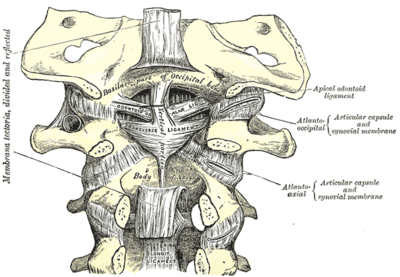Alar ligaments
Original Editor - Rachael Lowe
Top Contributors - Rachael Lowe, Kim Jackson, Evan Thomas, WikiSysop, Alistair James, George Prudden and Wendy Snyders
Description[edit | edit source]
The alar ligaments are two strong rounded cords that attach the dens of C2 (Axis) to the occipital condyles[1]. The ligaments' orientation is often described as supernatural but they tend to be more horizontal[1][2].The alar and transverse ligaments are the strongest ligaments that stabilise the cranocervical junction [3] with the alar ligament only failing at a mean force of 394 ± 52 N[1][1]
Attachments[edit | edit source]
Origin: Arise from either side of the dens/odontoid process (varying attachment points)[2]
Insertion: Usually the medial aspect of the occipital condyles but some studies have found it to insert on the lateral walls of the foramen magnum[2].
Function[edit | edit source]
- Limits C0-C2 extension[1]
- Limits axial rotation[1][3][2]
- Limits lateral bending[1][3]
- Limits flexion secondarily[3]
- Play a role in stabilizing C1 and C2, especially in rotation[4].
Pathology[edit | edit source]
Isolated alar ligament ruptures are rare[5] but are hypothesised to occur when the head is subjected to sudden rotation and hyperflexion[1]. Usually alar ligment ruptures occur together with fractures and other ligament injuries after trauma to the craniovertebral junction[5].
Examination[edit | edit source]
References[edit | edit source]
- ↑ 1.0 1.1 1.2 1.3 1.4 1.5 1.6 1.7 Ishak B, Glinski AV, Dupont G, Lachkar S, Yilmaz E, Iwanaga J, Unterberg A, Oskouian R, Tubbs RS, Chapman JR. Update on the biomechanics of the craniocervical junction, part II: alar ligament. Global Spine Journal. 2021 Sep;11(7):1064-9.
- ↑ 2.0 2.1 2.2 2.3 Osmotherly PG, Rivett DA, Mercer SR. Revisiting the clinical anatomy of the alar ligaments. European Spine Journal. 2013 Jan;22(1):60-4.
- ↑ 3.0 3.1 3.2 3.3 Rizvi A, Iwanaga J, Oskouian RJ, Loukas M, Tubbs RS. Duplication of the Alar Ligaments: A Case Report. Cureus. 2018 Jun 29;10(6).
- ↑ Magee DJ (2007). Orthopedic Physical Assessment (5th ed). St Louis, MO: Saunders Elsevier.
- ↑ 5.0 5.1 Unal TC, Dolas I, Unal OF. Unilateral alar ligament injury: diagnostic, clinical, and biomechanical features. World Neurosurgery. 2019 Dec 1;132:e878-84.







